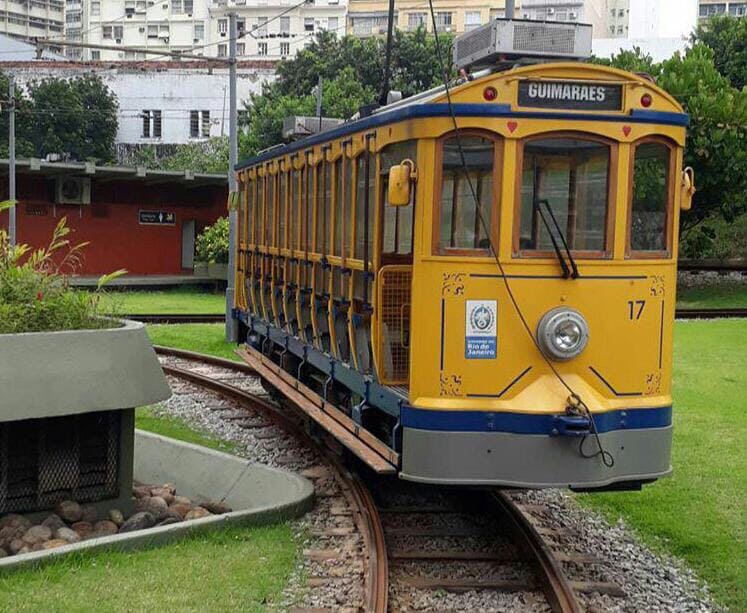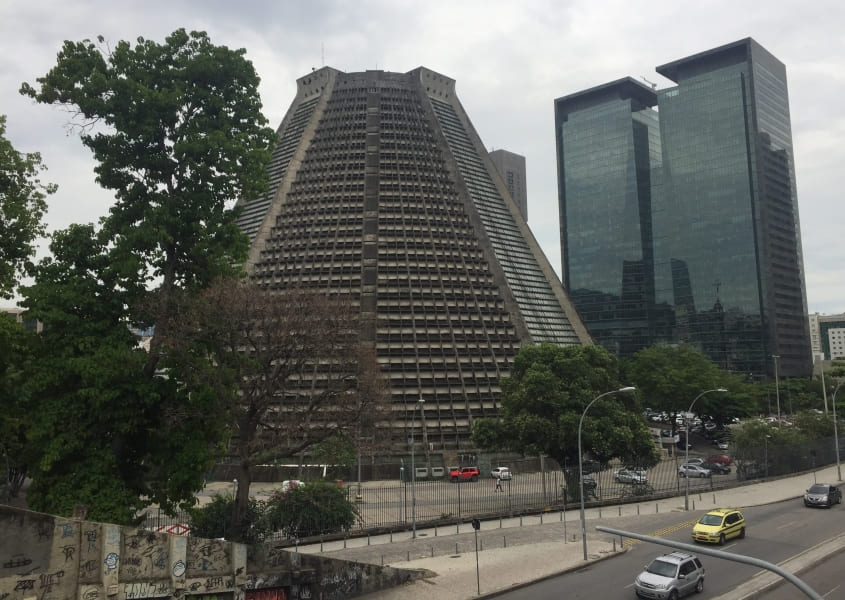Walking through Santa Teresa neighborhood, in Rio de Janeiro, is a fascinating journey whether you are an authentic Carioca or simply a tourist. The cobblestone streets, the beautiful mansions and the traditional tram are an invitation to discover a past of refinement and culture and to enjoy the Bohemian art of the present day.
A look into Santa Teresa neighborhood
Located at the top of a mountain range between the central and southern areas of Rio de Janeiro, Santa Teresa neighborhood arose around the convent of Santa Teresa, which was built in 1750 and until today houses the order of Barefoot Carmelites.
However, it was in the nineteenth century that Santa Teresa neighborhood began to expand, when wealthy families decided to build their imposing houses, inspired by the French architecture of the time.

Two events were decisive for the population growth in the neighborhood: an epidemic of yellow fever in 1850 and the inauguration of the Santa Teresa tram in 1896.
Due to the fact that the incidence of yellow fever and other diseases was higher in the lower part of the city, many people decided to settle at Santa Teresa Hill. Later on, thanks to the improvement of access, the neighborhood was consolidated and to this day attracts many locals and visitors.
How to get to the Santa Teresa neighborhood?
There are several ways to get to the Santa Teresa neighborhood, depending on your starting point and the means of transportation.
After all, Santa Teresa is pretty close to the neighborhoods of Gloria, Catete and Lapa, just to name a few.
By public Transportation
If you decide to go straight to the Santa Teresa tram station, the best option is to take the subway and get off at Carioca Station and then walk until there. There’s no way to miss it! The tram station is next to the Petrobrás headquarters building (Avenida República de Chile, 65).
Trams depart every 20 minutes from 8:00 in the morning. From noon, the interval decreases and there is a tram ever 15 minutes. The last tram leaves at 17:30.

Walking from Selarón Steps
It is also possible to begin the visit to the neighborhood from the Escadaria Selarón, also known as Selarón Steps. In fact, a lot of people end up opting for this access.
I decided to start my visit by tram because I thought it would be more interesting to go up the hill aboard of the traditional wooden vehicle. And personally I think it was the best option.
Firstly, it’s a great experience. It is not every day that you’ll have a chance to embark on a tram that maintains the same type of wooden structure used since its operations began. Secondly, because walking through the alleys of the neighborhood without being acquainted with it may not be safe.
Unfortunately, this is something I need to point out. The busiest streets of the neighborhood, due to the large concentration of tourists, are relatively safe and policed. However, it’s better to avoid the most remote places, especially during the nighttime.
By the way, an important piece of advice if you’re a tourist: try to program your visit to the city center for the morning or the afternoon. My visit was fine and didn’t make me feel insecure, but it is better to be alert all the time. Needless to say, this rule applies to any region of the city.
How to buy the tickets for Santa Teresa trams?
Tickets for trams can be purchased at the ticket office of the boarding station. They cost R$20.00 (December – 2017), but people over 60 years old travel free of charge.

You don’t need to keep your ticket for the return trip as it’s also free of charge.
How to explore Santa Teresa neighborhood?
You can be sure of one thing: if you only have one day to visit Santa Teresa, you will only get a brief idea of what it represents for the city. If you want to have the full experience, you’ll need to come back a few times or stay there for at least one night.

In fact, at Booking.com website, a partner of the blog, you can find several options that cater to every kind of budget. If you plan an overnight stay in Santa Teresa or any other hotel in Rio de Janeiro, you can make your reservation right here.
All purchases and reservations made through Turista FullTime partners don’t add any extra cost to you. However, they are a great contribution to assist the maintenance of the blog as it currently doesn’t have any sponsors.
You can check the options here:
A tour in Santa Teresa neighborhood
Well, but if you only have one day, don’t worry: you’ll be able to feel the relaxed and bucolic atmosphere of the neighborhood.

The cobblestone streets and old houses make you forget that you are in a great metropolis. You can also visit Chácara do Céu Museum or Parque das Ruínas, for instance.
Unfortunately, I don’t have any experiences to share about the places. I couldn’t visit either of them since they were closed for the holidays.
You will be amazed by the multitude of popular art objects from the workshops and souvenir shops.

Also by the cool decoration of the shops…

Besides, you will be certainly delighted by the traditional snacks and meals of the bars and restaurants.

Finally, you’ll also take spectacular photos of the city. Most likely, the photo session will begin from the moment the tram gets moving.
By the way, did you know that the initial stretch of the railroad is nothing less than the top of the Lapa Arches? Yes, you will be on top of them!

How to know in what part of Santa Teresa neighborhood you are?
It’s essential to keep in mind that Santa Teresa is a residential neighborhood with many streets and alleys. But, basically, for tourists, the attractions, bars and restaurants are concentrated near two well-known tram stops: Largo do Curvelo and Largo dos Guimarães.
First stop of the tram, Largo do Curvelo is the ideal stop to start the visit to the neighborhood by the Parque das Ruínas and Chácara do Céu Museum.

The second tram stop is at Largo dos Guimarães, a region where the gastronomic center of the neighborhood is concentrated. However, don’t worry about missing the right tram stops.
This most touristic area of the neighborhood is very well signalized and the distances are relatively short. You’ll be able to do everything on foot.
You can also choose to go down the hill of Santa Teresa using the 215 steps of Escadaria Selarón. Again, no need to worry as there are many indicative signs that won’t let you lose your way.

Whether you’ve bought the ticket to go uphill or not, you can take the tram to go back to the city center. The only advice I give to you is to pick it up at Largo dos Guimarães stop, because each tram can only take 32 people at a time. So, if it’s already full, you won’t be able to board along the way.
Where to eat well in Santa Teresa neighborhood?
I asked a friend who is a former resident of the neighborhood for advice on this topic. She gave me a list only someone who really knows the region can provide. The only problem is that the list is so extensive that I’ll have to go back there many times.
Authentic Brazilian Food
Among the alternatives, one that caught my attention was Bar do Mineiro, famous for its traditional feijoada. However, it turned out that everybody else had the same idea as me on that particular day!
Then I decided to try Portella‘s famous pão de queijo (Brazilian cheese bread), but there was a huge waiting line.

International Snacks
Finally, I opt to check Adega do Pimenta, specialized in German cuisine.
Although the waiter said that “he would be nice letting me in just for a snack”, I could enjoy some of the delicacies of my former “neighbors”. I opted for some meat croquettes and a mix of sausages. They were very tasty.

Specialised in fish
I didn’t opt for the restaurant Espírito Santa, though it was very well recommended by my friend, because I wasn’t in the mood to eat fish. However, it can be a good choice.

Well, according to what I witnessed that day, you may notice that stopping for a quick snack at lunchtime can be quite a challenge.
Besides the overcrowding, you may have to endure an annoyed face from the waiters if you don’t want a full meal. There was even an empty establishment that refused my entry because I just wanted to have a snack and a few beers.
It’s a pity as a happy tourist may often return and recommend the place. Whereas, an offended tourist does just the opposite…
Selarón Steps: an icon of Santa Teresa neighborhood
The famous staircase, whose entrance is located just in front of the 53 Rua Joaquim Silva St., connects Largo da Lapa to Santa Teresa neighborhood.
What would be a simple staircase for accessing the neighborhood became a tourist attraction thanks to the work of the artist Jorge Selarón.

Selarón Steps: a legacy of a Chilean artist
In the 1990’s, the Chilean-born painter and Ceramist decided to settle in Rio de Janeiro. He chose the hill of Santa Teresa to live and assemble his atelier. Around 1994, he began to fix tiles on the steps of the staircase in front of his house. Over time, he also began to coat several walls of the houses that stand along the ascent.

At the beginning of his project, Selarón used to employ tiles that he found in building sites scattered throughout the city.
Over time, he started incorporating tiles from all parts of the world, thanks to the contribution of tourists and countless admirers of his work.
Of course, every person who goes along the 215 steps pays attention to some particular tiles. I tried to pay attention to the ones related to the cities I’ve already visited.
And, of course, I looked for those related to the Netherlands, a country that I feel deeply connected to. I was pretty happy when I found some of them!

Besides, I am sure that every visitor, despite of his/her nationality, has the same familiar feeling of being represented by a particular national tile.

Moreover, it’s impossible not to stop many times to enjoy one tile or another and record the moment. For those who live there, Escadaria Selarón can be just a mere access to the neighborhood.
For those who are passing by, the staircase may be a path to places distant from their eyes, but close to their hearts. It is undoubtedly a fascinating route!
Extras to maximize your experience in Santa Teresa neighborhood
As I’ve had already mentioned, you can also choose to start the visit to Santa Teresa neighborhood from Escadaria Selarón. Or you can also do the reverse.
Whichever your choice, you will be in a very touristic region of the city. Escadaria Selarón stands pretty close to Arcos da Lapa and some of the bohemian alternatives that the neighborhood offers.
A good idea to maximize your time and have a chance to view more of the city is taking a stroll in the city center before or after going to Santa Teresa.
In this case, it will be possible to combine three other points of interest: the Municipal Theatre, the National Library and the Metropolitan Cathedral.
The latter, at a very short distance from Santa Teresa tram station. In case you decide to start your day visiting these previous attractions, it’s better to take the subway and get off at Cinelândia station. Then, you can walk to Santa Teresa tram station later on.
Check the map for the ideal route:
Rio de Janeiro and its many leisure options
And if you liked this post and want to know more about tourism in Rio de Janeiro, rest assured that there are many other activities to enjoy the Marvelous City.
I have much more to tell you about this beautiful place, which I call home. Rio is much more than beautiful beaches. Rio is also rich with culture!
Reference
https://pt.wikipedia.org/wiki/Santa_Teresa_(bairro_do_Rio_de_Janeiro)









